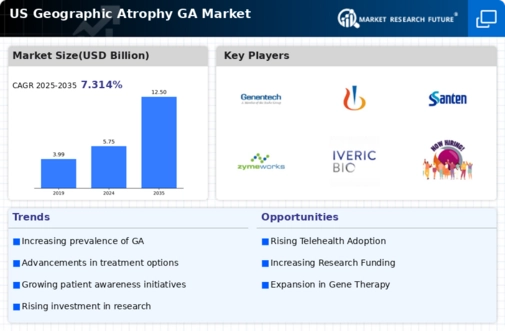Advancements in Diagnostic Technologies
Technological advancements in diagnostic tools are transforming the landscape of the geographic atrophy-ga market. Enhanced imaging techniques, such as optical coherence tomography (OCT) and fundus autofluorescence, allow for earlier and more accurate detection of geographic atrophy. These innovations facilitate timely intervention, which is crucial for managing the progression of the disease. As diagnostic capabilities improve, healthcare providers are better equipped to identify at-risk patients, leading to increased treatment initiation rates. The market for diagnostic devices is expected to grow, with estimates indicating a potential increase of 15% annually. This growth in diagnostic technology not only enhances patient outcomes but also stimulates demand for therapeutic solutions within the geographic atrophy-ga market.
Growing Investment in Ophthalmic Research
The geographic atrophy-ga market is experiencing a surge in investment directed towards ophthalmic research. Public and private funding initiatives are increasingly focusing on the development of novel therapies and treatment modalities for retinal diseases. In recent years, funding for ophthalmic research has seen an uptick, with estimates suggesting an increase of over 20% in research grants allocated to retinal diseases. This influx of capital is likely to accelerate the pace of clinical trials and the introduction of innovative therapies. As researchers explore new avenues for treatment, the geographic atrophy-ga market stands to benefit from a broader array of therapeutic options, ultimately enhancing patient care and outcomes.
Regulatory Support for Innovative Treatments
Regulatory bodies are increasingly supportive of innovative treatments for geographic atrophy, which is likely to drive market growth. Initiatives such as expedited review processes and orphan drug designations are designed to encourage the development of therapies for rare diseases, including geographic atrophy. The U.S. Food and Drug Administration (FDA) has implemented programs that facilitate faster access to new treatments, which may lead to a quicker introduction of effective therapies into the market. This regulatory environment fosters innovation and investment in the geographic atrophy-ga market, as companies are incentivized to develop and bring new solutions to patients in need.
Increased Awareness and Education Initiatives
Raising awareness about geographic atrophy and its implications is becoming a pivotal driver in the market. Educational campaigns aimed at both healthcare professionals and the general public are essential for improving understanding of the disease. As awareness grows, patients are more likely to seek medical advice and treatment, which could lead to an increase in diagnosed cases. Recent surveys indicate that nearly 60% of individuals over 50 are unaware of geographic atrophy, highlighting a significant opportunity for educational outreach. This increased awareness is expected to translate into higher demand for therapies, thereby positively impacting the geographic atrophy-ga market.
Rising Prevalence of Age-Related Macular Degeneration
The increasing incidence of age-related macular degeneration (AMD) is a critical driver for the geographic atrophy-ga market. As the population ages, particularly among individuals aged 65 and older, the prevalence of AMD is projected to rise significantly. Current estimates suggest that approximately 2.1 million Americans are affected by AMD, with a notable portion developing geographic atrophy. This demographic shift indicates a growing patient population that requires effective treatment options. Consequently, pharmaceutical companies are likely to invest in research and development to address this unmet medical need, thereby propelling the geographic atrophy-ga market forward. The aging population, combined with the increasing awareness of eye health, suggests a robust demand for innovative therapies targeting geographic atrophy.























Leave a Comment